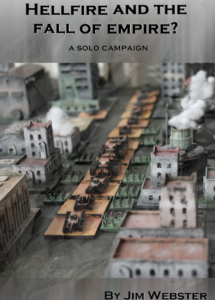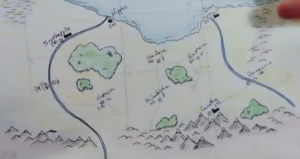 The Hellfire Campaign is dead, long live the Hellfire 2.0 Campaign.
The Hellfire Campaign is dead, long live the Hellfire 2.0 Campaign.
For reasons too boring to go into here, I have put the Hyde’s Reach campaign to bed. But the Jim Webster itch has not been fully scratched, so we turn our attention to “Hellfire and the Fall of Empire”. This stand alone book details the logistics and random generation for a stand-alone sci-fi campaign that echoes the best of Hammer’s Slammers.
You take charge of a ten city polity on the edge of an interstellar empire just as the economics of scale and political complexities send the strong arm of the Emperor into retreat. You get a couple of years of support to build a reserve and establish yourself before the Navy leaves and takes its orbital bombardment threat with it, and then the barbarians arrive at the gates.
While the ten cities are fixed in relation to each other, their sizes and major industry are determined by pulling cards from a deck, as is the surrounding terrain. The latter trends toward rough hills and mountains, making your little region a fertile and desirable land just ripe for conquering by the barbarians with which you share the planet. In my case, the kingdom proved to be more artsy and less political and the neighbors range from black-powder horse clans to a rival nation that is generally my equal.

Working in your favor is the potential to upgrade your tech, at a cost, and the relative instability of your neighbors who often find their invasion plans stymied by leadership turnover of their own and by their frequent willingness to take your coin to fight on your behalf. Mercenaries aren’t cheap, but they help preserve your forces and can be cheaper to rent than to fight. Their goals are randomly generated and range from one-off raids to city capture to full invasions, and each one has different odds for each. When combined with brief backgrounds, differing tech levels and commensurate orders of battle, these differing strategies give each barbarian tribe a different feel. You can opt to face all ten or, as I have, fill out your map with six to eight random kingdoms from which these forces will enter. The result is a unique world built ona standard foundation, which gives the game plenty of replayability and allows you to compare notes with other players.
“Hellfire and the Fall of Empire” isn’t a complete game. You can expect to flesh out the actual forces with other Hellfire titles or your own favorite divisional near-future ruleset. Some of the logistics need fleshing out as well, a task that I found easier be referring to “Hellfire Campaigns” and the core “Hellfire” ruleset. My playthrough cheats by turning the battles over to a complex random number generator, but the system does generate some interesting and meaningful battles perfect for the tabletop. They won’t always be balanced, but they will always have a lot of impact on the campaign and provide a richer experience than just another one-off fight.
For my tastes, the campaign hits the sweet spot of complex logistics without being too overbearing. At least not yet; my run is young and the barbarians are forcing me to spend a lot of money on an ever-growing army. Perhaps they will drive me to build an army fit for an empire of my own. Time will tell. Watch this space for more updates.

